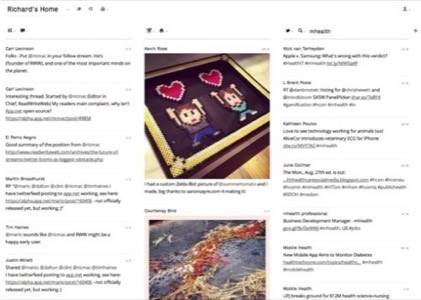
As streams of information become more popular on the Web, we need better ways to consume and manage them. Apps that allow you to aggregate content from different sources – Twitter, Facebook, blogs, news websites and more – may become very popular. That’s if they can overcome the increasingly walled gardens of Facebook and Twitter. Which makes creating a streams app a risky proposition, because there is no guarantee they’ll be able to access all of a user’s social data. A new service called State is trying, though. It came onto my radar this week and it passed my initial “I’m still using it after 30 minutes of tinkering” test.
State is currently in private beta. At first glance, it looks part FriendFeed, part TweetDeck, part iGoogle, and part something wholly new.
In an email to me, co-founder Joshua Lewis explained that he and his business partner Galen Wolfe-Pauly built State to try and answer the question of “what the future of the web looks like when you replace static content with streams of data”.
I mentioned a few services that State reminded me of, but for the founders it’s more like “the Photoshop of cloud data.” Lewis said that State is “a general purpose tool to manipulate, filter and publish streams of data.” Incidentally, State’s founders are already worried about the future of Twitter integration in State. It added App.net support soon after, partly as a hedge against Twitter pulling its data completely.
How State Works
You can add streams of content from up to four services (so far): Twitter, App.net, Instagram and Dropbox. This is the part that reminds me of a start page, like early Netvibes or iGoogle, because you end up with panels of content across the web page. You can also connect to Instapaper, enabling you to save content for later reading.

Then, like TweetDeck, you’re able to view various aspects of the stream. For Twitter, you can select to view content by home timeline, mentions, user, place, tag, search and list. The same principle applies to content from App.net and Instagram.

While State only connects to five services so far, you can imagine it eventually hooking into many more. This is where State reminds me of FriendFeed, the early feed management service acquired by Facebook just over three years ago. At the time it was acquired, FriendFeed could connect to 58 services.

One feature I really like in State is the ability to “follow” a page of streams that someone else has created. The State team has created several of these pages: News, Magazines, Food. Each page – or “workspace” to use the service’s parlance – is made up of many different streams of content. The Magazine one features the Twitter streams of various magazine publishers. There is limited ability to filter – for example, you can select to view only images from a stream. But I imagine more filtering options will be added over time.

By default your pages are private, but you can choose to share or make them public.

To get a tour of some of State’s other features, check out this demo. The service is in private beta, but you can register your interest here.
It’s clearly early days for State, but already I’m enjoying playing with it and building pages of streams. Keep an eye on this young service.
















